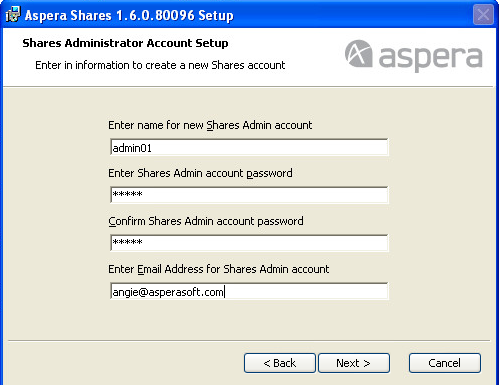-
Download the Aspera Shares installer file from http://downloads.asperasoft.com/en/downloads/34.
AsperaShares-version.exe
-
Run the Aspera Shares executable file and follow the onscreen
instructions.
AsperaShares-version.exe
Note: On Windows 2008 with UAC (User Account Control) enabled, you must run the installer as an Administrator. To do so, right-click the executable file and select Run as administrator. You may be asked to enter the administrator's password to allow the installer to make changes to the computer.Note: If you forget to make a note of the administrator’s password at installation time, you can reset it by running the following command:cd C:\shares\www rake aspera:admin NAME=bob PASSWORD=aspera EMAIL=example@aspera.com
After the license agreement dialog, the Shares Administrator Account Setup dialog appears. You are asked to choose a name for an Aspera Shares administrator account and to associate it with an existing email account:

On the next dialog, MySQL Setup, provide information to configure MySQL. The first field asks for a MySQL root account password. The root account for MySQL is created with the password you enter.
Enter the name of a MySQL account to create to run the Aspera Shares database:

In the Aspera Service Account dialog, enter the name of the user account to run Aspera services. By default, the user name is svcAspera.
If the machine is not joined to a Windows domain, you need only a local user, such as the default svcAspera, to run Aspera services. If the local account does not exist on the system, enter new credentials and click Next. The account is then created automatically. If the account already exists, enter the existing account password and click Next.
If the machine is joined to a domain, or you need to support requirements No. 2 or No. 3 from the following table, the type of account specified varies. See the following table for options. If the server is configured to accept the domain user login, use a domain account that has been added to the local administrator's group to run the services. You must create this domain account on the domain controller first.

No. Requirement Type of Service Account User 1 Provision local transfer users only. Local account. You can use a domain account with local administrator privileges, but is not required. 2 Provision Active Directory accounts for transfer users (users who want to transfer with your server are authenticated through Active Directory). Domain account with local administrator privileges. 3 Transfer users store files on a remote file system, such as an SMB file share. Domain account with local administrator privileges. In some cases, additional actions are required to support this requirement. See the aspera knowledgebase or contact http://support.asperasoft.com/home for assistance. For Choose Setup Type, select Typical:

The Ready to Install dialog appears. You can either click Back to change your installation settings, or Install to proceed with the installation. The installation process starts the MySQL service and the Aspera services.

- On the computer where Aspera Shares is installed, launch a web browser and navigate to http://shares_ip_address. Log in using the administrator username and password you created during the installation process:
- On the Shares Home window, click Admin. Then select Other > License to install the license.
-
Paste the license key into the Add/Change License dialog and click
Save.

- Configure the server's hostname or IP address to send emails from Aspera Shares to users by selecting Other > Web Server
-
Type the Aspera Shares server's hostname or IP address into the
Host field. It is used as part of the URL in system
emails to users.

By default the port is set to 443, and SSL/TLS is selected.
-
Secure Aspera Enterprise Server™ by doing the following:
- Secure an SSH server.
- Configure a firewall.
- Set up SSL for nodes.
For details on how to perform these tasks, see http://downloads.asperasoft.com/en/documentation/1.